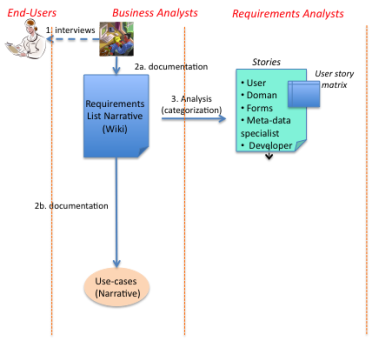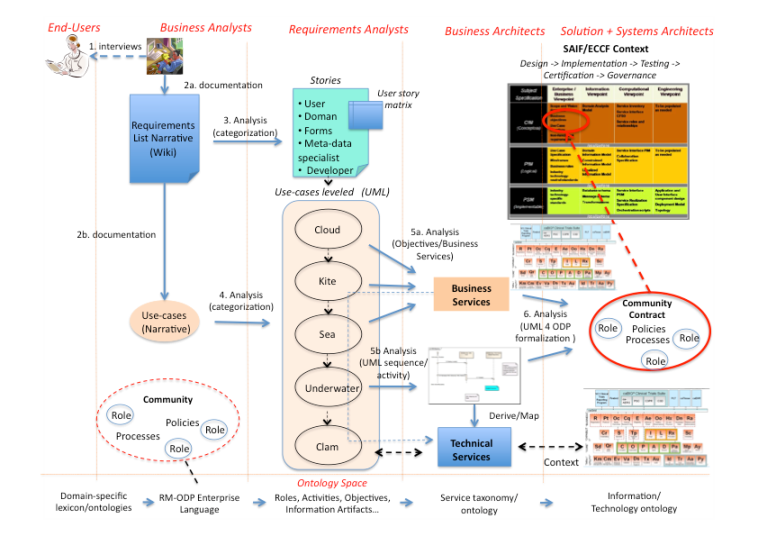Activities and outcomes before April 2010
Significant effort has been made and a number of business analysts were involved in the early stages of the requirements elicitation initiative. This included interviews of stakeholders within and outside the caBIG community, as depicted by step 1 in Figure 2-1 below.
As a result, a large number of requirements (100+) were identified and documented (see step 2a in Figure 2-1 below) on this page: Semantic Infrastructure Concept of Operations Initiatives - Requirements Master List.
Each requirement was also translated into a use case, documented as narrative text but structured in a tabular form, according to the NCI template (step 2b).
Subsequently, a further analysis was needed to categorize these requirements. An initial analysis suggested structuring use cases in several stories, namely: domain user stories, forms stories, metadata specialist stories and developer stories (step 3). These were documented at on the User Story Drafts page of this wiki.
In addition, a user story matrix was produced showing this categorization in a tabular form, while also providing references to initial candidate services used to support each story. These candidate services are documented in the infrastructure category of the NCI Enterprise Services periodic table.
Figure 2-1 below captures key activities and deliverables produced at the stages of the Requirements Elicitation effort.
Figure 2-1. Initial Stages of the Requirements Elicitation
April-June 2010 activities - towards a formalization approach
The sheer number of requirements, variety in use cases and the number of different users and systems to be developed to support these have highlighted the need to investigate formalization approaches. In particular, this was needed to:
- Support downstream software development efforts by handing over use case descriptions in a form that is more amenable to the designers and software developers; the aim is to support traceability from requirements via development to software testing.
- Support easier navigation of the significant body of requirements and use cases in a way similar to the existing ontology-based approaches; this is needed to better manage use case artifacts so that they can be amended more easily and in a more controlled manner, according to the new requirements of stakeholders - or extended with completely new use cases as new business requirements arise.
- Ensure that the formalization approach is aligned with the new SAIF developments.
In order to address these formalization requirements, the following two techniques and approaches were applied, as part of the subsequent analyses:
- use case levelling approach, initially proposed by A. Cockburn [1] and also used within NCI, augmented with the use of UML behavioural semantics, in particular sequence and activity diagrams
- use of the ISO RM-ODP standard, in particular the Enterprise Language [4] concept of community, to provide a way of formally structuring use cases, in a manner suitable for the capture of business architecture artifacts, such as roles, policies and processes
These additional elements of the requirements elicitation effort are captured in Figure 2-2 below. They will be described in the remaining of the paper, illustrated through the use of a specific requirement and several related use cases.
Figure 2-2. Requirements Analysis Roadmap for ECCF Traceability


